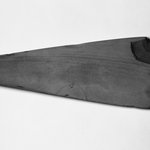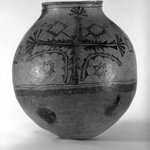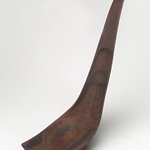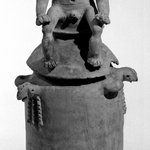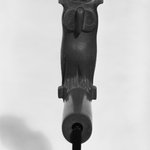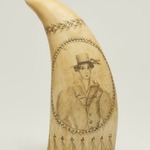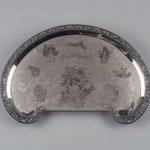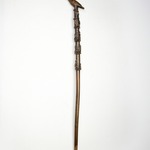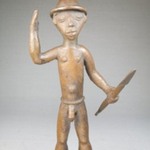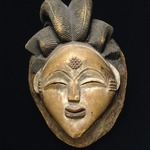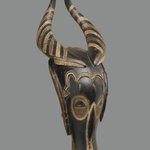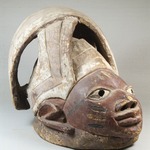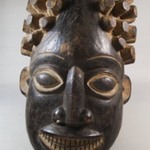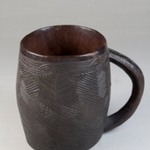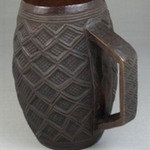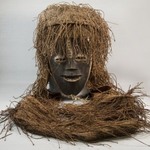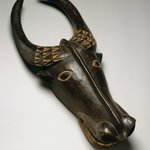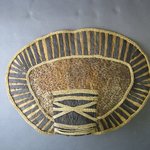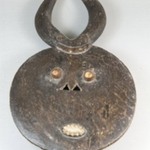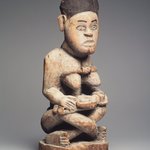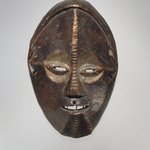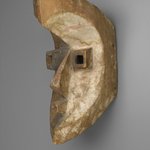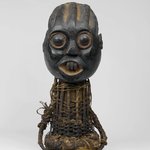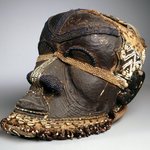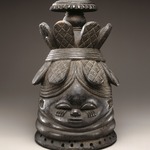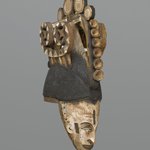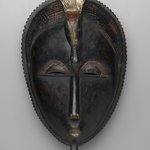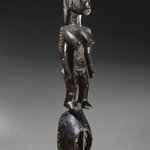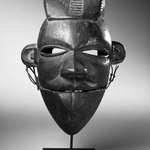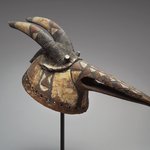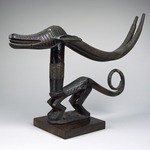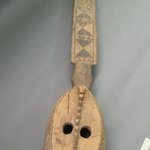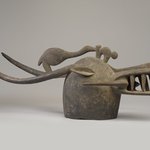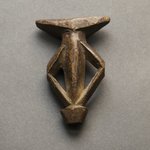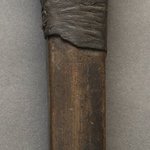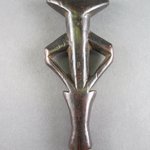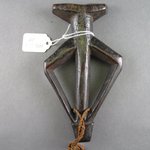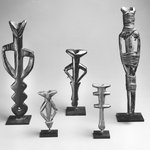

Mossi. Karanga Mask, early 20th century. Wood, pigment, 63 x 6 1/4 x 5 in. (160 x 15.9 x 12.7 cm). Brooklyn Museum, Gift of Mr. and Mrs. Milton F. Rosenthal in memory of Julia Forchheimer, 1992.74.1. Creative Commons-BY (Photo: Brooklyn Museum, 1992.74.1_SL3.jpg)
Karanga Mask
Arts of Africa
Becoming Another
The play associated with masquerade can lead to the invention of new types of identities and new hybrid, not-quite-human masked beings. Moments of passage—into or out of this world, through birth or death, or from childhood to adulthood—bring with them the potential for disorder. Masquerade can offer a vision of transcendence, suggesting that such concerns belong to a world beyond limited human understanding. By transforming its participants into nonhuman beings, masquerade performance transcends everyday human reality and reminds all involved that their immediate concerns are governed by forces larger than themselves.
Both of these masks by Mossi artists portray a being that combines human and animal characteristics. The tall, plank-like mask suggests a human-antelope hybrid, while the horizontal mask has both antelope and birdlike features.
Most Mossi masks symbolically depict totemic animals associated with particular clans. Each family has an animal with which it has mythological connections and which protects it from harm. Such masks would appear at the funerals of important family members, a moment loaded with personal, community, and spiritual significance. At the end of their own active lives, masks might go on to second lives as altars, providing connection to the spirits of commemorated ancestors.
The play associated with masquerade can lead to the invention of new types of identities and new hybrid, not-quite-human masked beings. Moments of passage—into or out of this world, through birth or death, or from childhood to adulthood—bring with them the potential for disorder. Masquerade can offer a vision of transcendence, suggesting that such concerns belong to a world beyond limited human understanding. By transforming its participants into nonhuman beings, masquerade performance transcends everyday human reality and reminds all involved that their immediate concerns are governed by forces larger than themselves.
Both of these masks by Mossi artists portray a being that combines human and animal characteristics. The tall, plank-like mask suggests a human-antelope hybrid, while the horizontal mask has both antelope and birdlike features.
Most Mossi masks symbolically depict totemic animals associated with particular clans. Each family has an animal with which it has mythological connections and which protects it from harm. Such masks would appear at the funerals of important family members, a moment loaded with personal, community, and spiritual significance. At the end of their own active lives, masks might go on to second lives as altars, providing connection to the spirits of commemorated ancestors.
CULTURE
Mossi
MEDIUM
Wood, pigment
DATES
early 20th century
DIMENSIONS
63 x 6 1/4 x 5 in. (160 x 15.9 x 12.7 cm) (show scale)
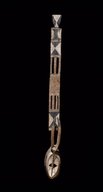


COLLECTIONS
Arts of Africa
ACCESSION NUMBER
1992.74.1
CREDIT LINE
Gift of Mr. and Mrs. Milton F. Rosenthal in memory of Julia Forchheimer
CATALOGUE DESCRIPTION
Oval face mask at base of flat vertical plank extension. Face bisected by raised vertical ridge with triangular cut out eyes on either side and linear designs incised on cheeks. Two long slender antelope-like horns extend from forehead, twisted and curved at tips. Surface of plank at back of head divided into painted rectangular quadrants with alternating motifs: triangular, herringbone and checkerboard designs. Finial form at top triangular. Two circular holes through sides at base of face. Colors: white, brown, and black. Condition: Some water damage around perimeter of face. Piece missing from base with crack extending around side. Repairs to several cracks toward top of plank - deepest one extends from top of plank downward. Paint missing in patches from surface.
MUSEUM LOCATION
This item is not on view
CAPTION
Mossi. Karanga Mask, early 20th century. Wood, pigment, 63 x 6 1/4 x 5 in. (160 x 15.9 x 12.7 cm). Brooklyn Museum, Gift of Mr. and Mrs. Milton F. Rosenthal in memory of Julia Forchheimer, 1992.74.1. Creative Commons-BY (Photo: Brooklyn Museum, 1992.74.1_SL3.jpg)
IMAGE
overall, 1992.74.1_SL3.jpg. Brooklyn Museum photograph
"CUR" at the beginning of an image file name means that the image was created by a curatorial staff member. These study images may be digital point-and-shoot photographs, when we don\'t yet have high-quality studio photography, or they may be scans of older negatives, slides, or photographic prints, providing historical documentation of the object.
RIGHTS STATEMENT
Creative Commons-BY
You may download and use Brooklyn Museum images of this three-dimensional work in accordance with a Creative Commons license. Fair use, as understood under the United States Copyright Act, may also apply.
Please include caption information from this page and credit the Brooklyn Museum. If you need a high resolution file, please fill out our online application form (charges apply).
For further information about copyright, we recommend resources at the United States Library of Congress, Cornell University, Copyright and Cultural Institutions: Guidelines for U.S. Libraries, Archives, and Museums, and Copyright Watch.
For more information about the Museum's rights project, including how rights types are assigned, please see our blog posts on copyright.
If you have any information regarding this work and rights to it, please contact copyright@brooklynmuseum.org.
RECORD COMPLETENESS
Not every record you will find here is complete. More information is available for some works than for others, and some entries have been updated more recently. Records are frequently reviewed and revised, and we welcome any additional information you might have.


